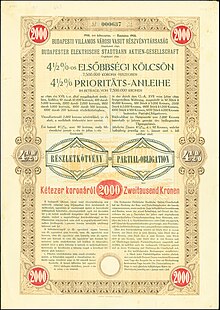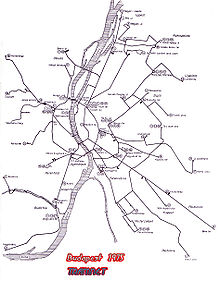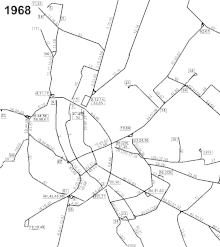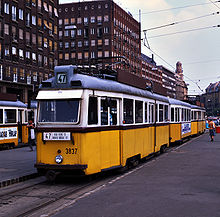Budapest tram
| Budapest tram | |
|---|---|
| Two ICS double units on line 6 in front of Budapest Nyugati pályaudvar station | |
| Basic information | |
| Country | Hungary |
| city | Budapest |
| opening | July 30, 1866 |
| electrification | October 1, 1887 |
| operator | BKV Zrt. |
| Infrastructure | |
| Route length | 155 km |
| Gauge | 1435 mm ( standard gauge ) |
| Power system | 600 volts = overhead line |
| business | |
| Lines | 35 + 4 |
| Cruising speed | 13.4 km / h |
| statistics | |
| Reference year | 2011 |
| Passengers | 393 million per year |
| Budapest tram network (December 2015) | |
The Budapest tram is the tram system of the Hungarian capital Budapest . It was opened as a horse-drawn tram in 1866 and electrified from 1887. Today the network is standard gauge , consists of 26 regular lines and seven repeater lines and is operated by the transport company BKV Zrt. operated. This is also responsible for the Metró Budapest , the Budapest trolleybus and partly the city bus transport . Likewise for the cogwheel railway to the Schwabenberg , which is integrated as line 60 into the line number system of the tram.
history
Before the First World War
The first horse-drawn tram line of the tram established by Moritz Jellinek , a Budapest businessman, ran on the Kálvin tér - Újpest route , which is still one of the main axes in Budapest's inner-city traffic. After the success of the first horse-drawn tram, competing companies soon built additional routes. This turned out to be a problem during the later expansion, connections between the competing networks did not exist and passengers often had to bridge the gaps between the networks on foot. After several mergers and the unification of Buda and Pest in 1873 , Budapesti Közúti Vaspálya Társaság , or BKVT for short , was the first major transport company to be established, which was still managed by Moritz Jellinek .
Budapest's first electric tram line started operating in 1887. It was meter-lane and ran from Nyugati pályaudvar via Nagykörút (Big Ring) to Király utca. It was a test operation that was financed by Siemens & Halske , a pioneer in electric traction. This first electric tram was a great success, which is why Siemens & Halske single-handedly founded their own tram company, Budapesti Városi Vasút , or BVV for short . When Siemens later sold its shares in BVV, the company was renamed Budapesti Villamos Városi Vasút , abbreviated BVVV (Budapest Electric Light Rail ).
The first standard-gauge electric tram line was opened in 1889, at which time the BKVT began to electrify its horse-drawn tram lines in quick succession. This led to strong competition between BKVT and BVVV, and both companies pushed the further expansion of their networks. The residents of Budapest benefited from this competition. Even before the First World War , the Budapest tram network was one of the largest in Europe. The BKVT used odd line numbers (1 to 77) for its lines, while the BVVV used even numbers (2 to 50). The two networks were operationally self-sufficient; there were no jointly operated sections.
Interwar period
At the end of the First World War, the economic situation in Hungary was difficult. As a result, the tram network was also in poor condition; no investments could be made. After the two revolutions of 1919, there was an improvement in 1920. Both tram companies realized that working together would lead to greater efficiency. In 1923 the two companies merged to form Budapest Székesfövárosi Közlekedési Rt. , BSZK for short . The two subnetworks were then adapted, some of which had different technical standards.
After the merger, the new company began experimenting with twin trams in 1924 . Budapest was the first tram company in the world to use this form of operation. In this way, end points without a transfer track or turning loop could also be served with longer units. Another advantage was the higher drive power of such a combination. Later on, sidecars were also added between the railcars , which resulted in tram trains that were unusually long for the time and could carry 200 passengers without any problems.
The entire route network was renewed and the routes in the narrow streets of downtown Pest were closed. New connections were built so that longer, more efficient and more passenger-friendly lines could be put into operation. In addition, the BSZK started its first bus operation in the interwar period.
After the Second World War
The situation after the Second World War was difficult, all bridges over the Danube were destroyed and the power supply was not guaranteed. In 1950, a new transport company was founded, the state-owned Fővárosi Villamosvasút , or FVV for short . The tram and the trolleybus operation were henceforth part of the FVV - the subway, the suburban railway Helyiérdekű Vasút (HÉV) and the urban bus service were not.
Because new vehicles could not be financed, the FVV began in the post-war period with the reconditioning of up to 50-year-old trams with wooden bodies. The cabling was renewed, the engines and the bogies reinforced. Many two-axle vehicles also got new steel superstructures. Almost all wagons have also been upgraded for operation in multiple units .
At the same time, the UV trains characteristic of Budapest were introduced. These cars dominated the Budapest tram fleet for several decades. The UV were four-axle open- plan cars with electric door drives. The formation of three- car trains using an additional two-axle intermediate car made it possible to carry up to 350 passengers with one UV train. This high capacity was favored by the high proportion of standing space in these vehicles. From the 1950s onwards, the tram network was rationalized and many unprofitable routes were given up.
In 1967, the entire local public transport system in the capital was brought into a joint company, when the BKV, which still exists today, was founded. One consequence of this merger was the further expansion of the metro, while the tram tended to be neglected. At the time, their vehicles were between 25 and 70 years old and therefore expensive to operate and maintain. However, no funds were available for a fundamental modernization, the few funds available were used to maintain the existing infrastructure.
Since 1989
After the political turning point in 1989 and the associated departure from the planned economy, Hungary ran into economic difficulties. The high rate of inflation, the sharp rise in electricity prices and the increase in private motorized traffic also caused financial problems for the BKV. In this context, the price of a single journey increased from five forints in 1990 to more than 200 forints in 2006.
Many tram routes were shut down in the 1990s, the line network shrank from the original 60 to only about 30 tram lines. The modernization measures after 1992 mainly concerned the renewal of the track on the Great Ring, which benefited lines 4 and 6 from Széll Kálmán tér to Móricz Zsigmond körtér and to Újbuda-központ .
After the economic crisis of the 1990s, the company was able to recover. Further modernizations and improvements were carried out: Line 14 was extended over an unused underground route. Likewise line 1, which now serves the entire outer ring from Pest (Hungária körút) to the end of line 17 on the banks of the Danube. Line 3 was also created by linking lines 13 and 63; it drives on a ring even further out than line 1. The most important innovation in recent years was the procurement of low-floor wagons from the manufacturers Siemens (length 54 meters) and CAF (length 34 or 56 meters - the latter are considered to be the longest tram cars in the world).
Future projects
- Line 1 - extension to the south
In the south, line 1 is to be extended from the previous terminus Etele út / Fehérvári út to Kelenföld train station (Kelenföld vasútállomás). There are connections to regional and long-distance traffic and to international trains (e.g. in the direction of Balaton or Vienna) as well as to the M4 underground line. The new route is already under construction and completion is planned for 2019. The route was opened on July 10, 2019.
Vehicle fleet
Line vehicles
Articulated trolleys from Ganz
The double articulated railcars with the designation ICS were built by Ganz between 1967 and 1978, the type was developed for Budapest and was not sold in any other city. These eight-axle wagons were used in double traction on lines 4 and 6 until 2007 , and they only run as solo wagons on other lines.
Between 1997 and 1999 a total of 30 vehicles of this type were modernized and converted to the type KCSV7 . Although these cars look like the ICS cars that have not been modernized, the technical parts have been completely redesigned.
Each car is 26,900 mm long and 2300 mm wide.
Tatra Mountains
The Tatra T5C5 tram railcar is a series of large-capacity railcars manufactured by the Czechoslovakian manufacturer ČKD Tatra and developed for the Budapest tram network. These four-axle Czech railcars were built between 1980 and 1984. 322 units were purchased, so far no car has been parked. These fake bidirectional cars with only one driver's cab can only run in two- or three-car trains. There are no plans to use solo cars.
After 2000 it became necessary to modernize the old vehicles, so the types T5C5K2 and T5C5K2M were created. The renovated trains are equipped with new controls and new engines, and it is planned to modernize each car.
A solo car is 14,700 mm long and 2,500 mm wide.
TW 6000
These double-articulated railcars were originally built for the Hannover Stadtbahn , hence their nickname Hannoveri (Hannoversche Wagen). They were built from 1974 and after their retirement at Üstra sold to the BKV from 2002.
First 76 cars were procured, they were painted yellow and given the car numbers 1500–1575, even if the old Hanoverian 6000 number can still be found inside most of the cars. Because of the warmer climate, the top-hung windows were replaced by sliding windows. The wagons were a marked improvement over the more than 50-year-old material they were replacing. However, they have a high entrance from the street, because they were actually mostly intended for elevated platforms that are not available in Budapest. The vehicles run on lines 3, 24, 28A, 42, 50, 51, 51A, 52, 62 and 69.
In 2010, the eight TW 6000 tram from The Hague to Budapest were also sold. Since then, Üstra has sold more light rail vehicles of this type to BKV; today 114 former Hannoversche TW 6000s are in operation in Budapest. Other vehicles serve as spare parts donors in Budapest. The cars built by DÜWAG have the numbers 1500 to 1592, those of LHB have the numbers 1600 to 1624.
Combino
The 40 Combino cars in Budapest, numbered from 2001 to 2040, are the first brand new tram vehicles to be delivered in over 25 years. The Combino is a low-floor articulated tram from Siemens, of which other versions also run in Augsburg and Potsdam , among others . The type used in Budapest is six-part, with the car bodies being longer and made of steel in contrast to the other Combinos. The second and fourth car bodies are wider. They also only have single seats and therefore have a large standing capacity. At 54 meters long, they were at times the longest tram cars in the world. In 2006 they were used for the first time on line 4/6 on Nagykörút (Big Ring), the busiest tram line in Budapest. Her nickname is óriáshernyó (giant caterpillar ). The last unit was delivered on May 4, 2007. The platforms along line 4/6 were raised for barrier-free entry.
Since 2016, the Combinos have also been running on Line 1 on weekends and during school holidays.
Urbos
In 2014, the operator BKV signed a contract with the Spanish company CAF for the purchase of 37 trams with an option for 87 additional vehicles. Ten more vehicles were ordered just a month later. The first vehicle with the number 2201 was delivered on March 11, 2015.
Between 2015 and 2016, a total of 47 bidirectional CAF Urbos vehicles were delivered to Budapest. 35 of them are five-part, 34 meters long, and are in use on lines 3, 17 and 19. They were given vehicle numbers 2201 to 2235. The twelve others - with vehicle numbers 2101 to 2112 - are nine-part. With a length of 56 meters, they are currently the longest tram cars in the world and are used on Line 1.
As part of the option, another five nine- and 21 five-part tram cars were ordered in autumn 2017. The latter will be used on lines 50, 56 and 61. The stops on these lines have been converted for stepless entry and exit. Financing is provided by EU funds.
Vehicle types at a glance
| image | designation | Number (originally) | Number (currently) | Wagon number range | Construction year | in operation | Lines |
|---|---|---|---|---|---|---|---|

|
Articulated tram from Ganz (ICS) | 149 | 39 | 1300, 1400 | 1967-1968 | since 1967 | 19, 47 / 47B, 48, 49 |

|
All of KCSV – 7 | 30th | 1300, 1400 | 1997-1999 | since 1997 | 2.24 | |

|
ČKD Tatra T5C5 | 322 | 4000-4349 | 1978-198 | since 1978 |
Two-car trains : 12, 17, 28 / 28A, 37 / 37A, 41, 56 / 56A, 59 / 59A / 59B, 61 three-car trains: 1, 12, 14 |
|

|
DÜWAG TW 6000 | 113 | 1500-1620 | 1975-1988 | since 2001 | 3, 24, 28 / 28A, 37 / 37A, 42, 50, 51 / 51A, 52, 62 / 62A, 69 | |

|
Siemens Combino ♿ |
40 | 2001-2040 | 2006-2007 | since 2006 | 1, 4/6 | |

|
CAF Urbos 3 long version ♿ |
12 | 2101-2112 | 2015-2016 | since 2016 | 1 | |

|
CAF Urbos 3 short version ♿ |
35 | 2201-2235 | 2015-2016 | since 2015 | 3, 17, 19, 41 | |
Former vehicles
UV car
The UV railcars were built in four series (UV1, UV2, UV3, UV5) by Ganz between 1956 and 1965. This type is a four-axle and double-traction tram car. A total of 375 units were built, which dominated Budapest tram operations for many years. The series have the car numbers 3200-3249 (UV1), 3250-3299 (UV2), 3300-3474 (UV3) and 3800-3899 (UV5). The UV4 only existed on paper, but it wasn't built.
The forerunners of these cars were the so-called Stukas . They got this nickname because of their howling engines, the noise of which was very similar to the German Stuka fighter planes.
Since August 20, 2007, these cars have disappeared from the streets of Budapest. They now only drive as a museum car.
"Bengali"
The FVV CS (or nicknamed Bengáli ) was built between 1961 and 1975 in Budapest and Debrecen in the workshops of the transport companies to alleviate the shortage of articulated vehicles. The procurement of new cars was necessary at the time, but the Hungarian cities could hardly have afforded new vehicles. Therefore, as a preliminary solution, these simple vehicles were made. The built-in technology was already considered obsolete when it was built, which meant that this type did not enjoy long popularity. All cars were parked until 1979.
Museum car
Nostalgia trips are regularly organized in Budapest, and these vehicles can be used.
| Museum cars that are currently operational | ||||||||
|---|---|---|---|---|---|---|---|---|
| image | Type | number | Wagon number | Construction year | In use as a museum car | |||

|
Type L | 1 | 436 | 1913 | since 1987 | |||
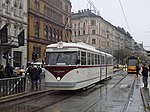
|
Bengáli (FVV CSM – 2) |
1 | 3720 | 1961 | since 2018 | |||

|
Bengali FVV CSM – 4 |
1 | 1233 (previously 492) |
1964 | since 2012 | |||

|
Type S | 2 | 611 | 1908 | since 1987 | |||

|
1820 | 1907 | since 2018 | |||||
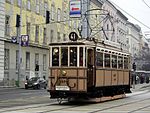
|
Type V | 1 | 1074 | 1912 | since 2009 | |||
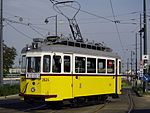
|
Type G | 1 | 2624 | 1906 | since 2012 | |||
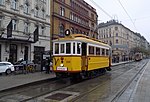
|
Type K | 1 | 2806 | 1911 | since 2018 | |||
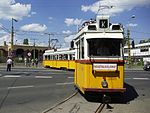
|
All UV | 4th | 3873, 3885, 3888, 3898 | 1964 | since 2007 | |||
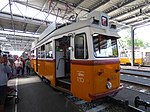
|
Quite MUV | 1 | 3430 | 1960 | since 2018 | |||

|
MWG EP sidecar | 1 | 5869 | 1951 | since 2007 | |||
| FP sidecar | 1 | 6010 | 1954 | since 2007 | ||||
Lines
| Current lines | ||||||||
|---|---|---|---|---|---|---|---|---|
| line | since | Line route | length | Duration [min] | type of car used | Remarks | ||
| 1 | 1984 | Bécsi út / Vörösvári út ⇒ Kelenföld vasútállomás M | 18.2 km | 51 min | CAF Urbos 3, Combino NF12B, Tatra T5C5, Tatra T5C5K2 |
From March 20, 2015, line 1 will continue to Újbuda via the Rákóczi bridge | ||
| 2 | 1942 | Jászai Mari tér ⇒ Közvágóhíd H | 6.0 km | 20 min | Quite KCSV-7 | Short trips Jászai Mari tér - Boráros tér (2A) were discontinued on February 23, 2013 | ||
| 3 | 2001 | Mexikói út M ⇒ Gubacsi út / Határ út | 13.3 km | 49 min | TW 6000, CAF Urbos 3 |
|||
| 4th | 1950 | Széll Kálmán tér M ⇒ Újbuda-központ M | 8.5 km | 29 min | Combino NF12B, Entire KCSV-7 |
|||
| 6th | 1945 | Széll Kálmán tér M ⇒ Móricz Zsigmond körtér M | 8.3 km | 29 min | Combino NF12B | |||
| 12 | 1955 | Angyalföld kocsiszín ⇒ Rákospalota, Kossuth utca | 4.7 km | 16 min | Tatra T5C5K2 | only on the weekend | ||
| 14th | 2017 | Lehel tér M ⇒ Káposztásmegyer, Megyeri út | 11.1 km | 33 min | Tatra T5C5K2 | |||
| 17th | 2016 | Bécsi út / Vörösvári út ⇒ Széll Kálmán tér M ⇒ Savoya Park | 14.6 km | 51 min | Tatra T5C5, Tatra T5C5K2, CAF Urbos 3 |
|||
| 19th | 1964 | Bécsi út / Vörösvári út ⇒ Kelenföld vasútállomás M | 10.9 km | min | All CSMG, CAF Urbos 3 |
|||
| 24 | 1951 | Keleti pályaudvar M ⇒ Közvágóhíd H | 5.2 km | 20 min | TW 6000, Ganz KCSV-7 |
|||
| 24G | 2015 | Mester utca / Ferenc körút ⇒ Keleti pályaudvar M or Hidegkuti Nándor Stadium | 4.6 / 5.1 km | 18 min | Combino NF12B, TW 6000 |
|||
| 28 | <1950 | Blaha Lujza tér M (Népszínház utca) ⇒ Izraelita temető | 10.8 km | 39 min | Tatra T5C5, TW 6000 |
|||
| 28A | 2016 | Blaha Lujza tér M (Népszínház utca) ⇒ Új köztemető (Kozma utca) | 10.1 km | 37 min | Tatra T5C5, TW 6000 |
Short trips on line 28 | ||
| 28B | 2015 | Keleti pályaudvar M ⇒ Új köztemető (Kozma utca) | 9.7 km | min | Tatra T5C5, TW 6000 |
Short trips on line 28, only on October 31 and November 1 | ||
| 37 | <1950 | Blaha Lujza tér M (Népszínház utca) ⇒ Új köztemető (Kozma utca) | 9.7 km | 30 min | TW 6000 | |||
| 37A | 1992 | Blaha Lujza tér M (Népszínház utca) ⇒ Sörgyár | 19 min | TW 6000 | Short trips on line 37 | |||
| 41 | 1963 |
Bécsi út / Vörösvári út ⇒ Kamaraerdei Ifjúsági Park Bécsi út - Zsigmond tér - Franconia Leó utca - Margit híd, budai hídfő - Bem rakpart - Várkert rakpart - Szent Gellért rakpart - Szent Gellért rakpart - Szent Gellért térla - Bartútús - Mehmond térla - Bartútús - Mehmond érlazótús Kitérő út - Ady Endre út - Kőberek - Susulyka utca - Kamaraerdei út |
18.3 km | 62 min | Tatra T5C5, CAF Urbos 3 |
|||
| 42 | 1959 | Határ út M ⇒ Kispest , Tulipán utca | 3.0 km | 8 min | TW 6000 | |||
| 47 | 1960 | Deák Ferenc tér M ⇒ Városház tér | 8.8 km | 30 min | Quite CSMG | |||
| 47B | 2016 | Kamaraerdei Ifjúsági Park ⇒ Deák Ferenc tér M | 12.6 km | 42 min | Quite CSMG | Operates only early on weekdays in the direction of Deák Ferenc tér M | ||
| 48 | 2014 | Deák Ferenc tér M ⇒ Savoya Park | 8.0 km | 27 min | Quite CSMG | only on Saturdays, every 15 minutes | ||
| 49 | <1950 | Deák Ferenc tér M ⇒ Kelenföld vasútállomás M | 5.4 km | 19 min | Quite CSMG | |||
| 50 | <1950 | Határ út M ⇒ Pestszentlőrinc, Béke tér | 8.0 km | 24 min | TW 6000 | |||
| 51 | 2011 | Mester utca (Ferenc körút) ⇒ Nagysándor József utca | 6.6 km | 33 min | TW 6000 | before line 21 / 21A, before that line 30 / 30A | ||
| 51A | 2011 | Mester utca (Ferenc körút) ⇒ Ferencváros vasútállomás - Málenkij Robot Emlékhely | 2.3 km | 10 min | TW 6000 Entirely KCSV-7 Entirely CSMG |
Short trips on line 51 | ||
| 52 | 1980 | Határ út M ⇒ Pesterzsébet, Pacsirtatelep | 7.0 km | 23 min | TW 6000 | |||
| 56 | 2016 | Hűvösvölgy ⇒ Budafok , Városház tér | 17.3 km | 53 min | Tatra T5C5K | |||
| 56A | 2016 | Hűvösvölgy ⇒ Móricz Zsigmond körtér | 11.2 km | 34 min | Tatra T5C5K | Short trips on line 56 | ||
| 59 | <1950 | Szent János kórház ⇒ Farkasrét, Márton Áron tér | 5.3 km | 20 min | Tatra T5C5K | |||
| 59A | 2008 | Széll Kálmán tér M ⇒ Farkasrét, Márton Áron tér | 4.1 km | 14 min | Tatra T5C5K | Short trips on line 59 | ||
| 59B | 2016 | Hűvösvölgy ⇒ Farkasrét, Márton Áron tér | 10.8 km | 34 min | Tatra T5C5K | Operation only on working days early in the morning | ||
| 60 | <1950 | Városmajor ⇒ Széchenyi-hegy, Gyermekvasút | 3.7 km | 15 minutes | SGP | Rack railway | ||
| 61 | 1943 | Hűvösvölgy ⇒ Móricz Zsigmond körtér M | 11.0 km | 34 min | Tatra T5C5K | |||
| 62 | 1964 | Blaha Lujza tér M (Népszínház utca) ⇒ Rákospalota, MÁV-telep | 13.7 km | 50 min | TW 6000 | |||
| 62A | 2008 | Kőbánya alsó vasútállomás (Mázsa tér) ⇒ Rákospalota, MÁV-telep | 9.0 km | 33 min | TW 6000 | Short trips on line 62 | ||
| 69 | 1973 | Mexikói út M ⇒ Újpalota, Erdőkerülő utca | 6.5 km | 23 min | TW 6000 | |||
After the opening of the M2 and M3 underground lines in the 1970s, many tram lines were discontinued or cut. After that, the remaining tram lines should run as feeders to the subway.
| Set lines (selection) | ||||||||
|---|---|---|---|---|---|---|---|---|
| line | business | from | over | to | Remarks | |||
| 1 | 1954-1961 | Újpest, vasúti híd | Váci út | Nyugti pályaudvar (West Railway Station) | was renamed to line 3A in 1961, from 1982 the entire line was discontinued due to the extension of the M3 underground line to Újpest | |||
| 1A | 2000-2013 | Bécsi út | Vörösvári út - Árpád híd - Róbert Károly körút - Hungária körút - Könyves Kálmán körút | Népliget M | Short trip on line 1; After the extension of line 1, short trips 1A were discontinued, main line 1 runs more often | |||
| 2A | 1973-2013 | Jászai Mari tér | Széchenyi rakpart - Belgrád rakpart - Közraktár utca | Boráros tér H | Short trips on line 2; Main line 2 has been running more often since 2013, line 2A has been discontinued | |||
| 3 | 1902-1981 | Nyugati pályaudvar (West Railway Station) | Váci út | Újpest, Fóti út | 1981 was shortened instead of Westbahnhof to Árpád híd; Suspension due to extension of the M3 underground line to Újpest | |||
| 4A | 1962-1972 | Petőfi híd, budai hídfő (from 1963 by Fehérvári út) | October 23rd. - Irinyi J. utca. - Petőfi híd - Nagykörút | Margit híd, budai hídfő | Short trips on line 4, which runs more often from 1972. | |||
| 5 | 1955-1974 | Flórián tér | Szentendrei út | Filatorigát (from 1958 to Hévízi út) | was extended in 1958 from Filatorigát to Hévízi út | |||
| 5A | 1958-1974 | Flórián tér | Szentendrei út | Filatorigát | was discontinued together with main line 5 | |||
| 7th | 1950-1961 | Margit híd | Frankel Leó út - Bécsi út | Óbudai kocsiszín | from 1958 was only taken to Margit Kórház (hospital); continues as line 17 from 1962 | |||
| 7i | 1967-1970 | Rákospalota, Kossuth utca | Árpád út | Fóti út | ||||
| 8th | 1948-1952 | Városliget | Podmaniczky utca | Kossuth Lajos tér | ||||
| 8th | 1955-1980 | Újpest, Szent István tér | Károlyi István utca - Baross utca - Irányi Dániel utca | Megyeri út | bus route 147 was set up as a replacement | |||
| 9 | circa 1930-1986 | Margit híd | Bem rakpart - Várkert rakpart - Szent Gellért rakpart - Bartók Béla út - Móricz Zsigmond körtér - Fehérvári út - Leányka utca | Budafok, Városház tér | was shortened in 1972 to Batthyány tér instead of Margit híd because of the extension of the suburban railway line H5 | |||
| 9A | 1961-1970 | Margit híd | Bem rakpart - Várkert rakpart - Szent Gellért rakpart - Bartók Béla út | Móricz Zsigmond körtér | Short trip on line 9 | |||
| 9A | 1970-1972 | Móricz Zsigmond körtér | Fehérvári út | Albertfalva kitérő | Short trip of line 9, from 1970 line 9A runs in the other direction | |||
| 10 | 1950-1985 | Újpesti víztorony (from 1980 from Rákospalota, Kossuth utca) | Árpád út - Váci út | Fóti út (from 1954 up to Megyeri Csárda) | bus route 104 was set up as a replacement | |||
| 10A | 1955-1964 | Fóti út | Váci út - Árpád út - Fő út | Rákospalota, Kossuth utca | Short trip on line 10, instead of Kossuth utca, was shortened to Újpesti víztorony in 1965 | |||
| 10B | 1960-1961 | Újpesti víztorony | Árpád út - Váci út | Megyeri út | 2. Short trip on line 10 | |||
| 11 | 1950-1981 | Margit híd | Frankel Leó út - Bécsi út - Nagyszombat utca - Pacsirtamező utca - Vörösvári út | Bécsi út | ||||
| 11 | 1990-1994 | Káposztásmegyer, Szilas-patak | Pozsonyi utca - István út - Görgey Artúr utca - Szilágyi utca - Külső Szilágyi út | Angyalföld, Forgalmi telep | Short trip on line 14 | |||
| 12A | 1961-1967 | Nyugati pályaudvar (West Railway Station) | Váci út - Lehel utca - Béke utca - István út - Görgey Artúr utca - Szilágyi utca - Pozsony utca | Újpest, Szilágyi utca | Short trip on line 12 | |||
| 13 | 1983-2001 | Örs vezér tere | Fehér út - Jászberényi út - Kőrösi Csoma Sándor út - Bihari út - Ecseri út - Epreserdő utca - Gubacsi út | runs further than line 3 | ||||
| 14A | 1961-1967 | Nyugati pályaudvar (West Railway Station) | Váci út - Lehel utca - Béke utca - Lebstück Mária utca | Újpest, Pozsonyi út | Short trip on line 14 | |||
| 15th | 1963-1977 | Újpest, forgalmi telep | Váci út - Dráva utca - Pozsonyi út | Jászai Mari tér | as a replacement, trolleybus line 79 was extended to Jászai Mari tér | |||
| 15A | 1963-1977 | Váci út | Dráva utca - Pozsonyi út | Jászai Mari tér | Short trip on line 15 | |||
| 16 | 1950-1953 | Népliget | Baross utca | Kálvin-tér | ||||
| 16A | 1950 | Orczy-tér | Baross utca | Kálvin-tér | Short trip on line 16 | |||
| 16 | 1955-1961 | Nyugati pályaudvar (West Railway Station) | Váci út - Lehel utca - Béke utca - Gyöngyösi utca | Short trip on line 14 | ||||
| 17th | 1958–1962 | Déli pályaudvar (South Station) / From 1960 by Szent János kórház / | Szilágyi Erzsébet fasor - Margit körút - Frankel Leó út - Bécsi út - Nagyszombat utca - Pacsirtamező utca - Vörösvári út | Bécsi út | was diverted from 1960 to Szent János kórház instead of the Südbahnhof | |||
| 17th | 1962-1981 | Margit híd | Frankel Leó út - Bécsi út - Nagyszombat utca - Pacsirtamező utca - Vörösvári út - Bécsi út | was shortened to Margit híd in 1962 | ||||
| 18th | 1972-2016 | Hűvösvölgy | Széll Kálmán tér - Krisztina krt. - Szent Gellért tér - Móricz Zsigmond körtér - Fehérvári út | Savoya Park | ||||
| 19th | 1964-1972 | Kelenföld vasútállomás (Kelenföld train station) | Bartók Béla út - Erzsébet híd - Rákóczi út | Keleti pályaudvar (Eastern Railway Station) | has been operating since December 21, 1972 instead of Keleti pályaudvar to Batthyány tér | |||
| 20th | 1950-1951 | Közvágóhíd | Könyves Kálmán-körút | Népliget | ||||
| 20th | 1953-1956 | Ferenc körút | Mester utca | Pesterzsébet, Szabótelep | ||||
| 20A | 1953-1954 | Ferenc körút | Mester utca | Koppany utca | Short trip on line 20 | |||
| 20th | 1960-1977 | Ferenc körút | Mester utca - Könyves Kálmán körút - Vajda Péter utca - Orczy út - Népszínház utca | Blaha Lujza tér | was shortened from 1962 to Golgota tér and from 1976 to Népliget; from January 1, 1977 extended to Golgota tér again; discontinued on April 24, 1977 | |||
| 20A | 1962-1970 | Ferenc körút | Mester utca- Könyves Kálmán körút | Népliget | Short trip on line 20 | |||
| 21st | 1950-1954 | Keleti pályaudvar (from December 21, 1950 by Váci út) | Fiumei út | Nagyvárad tér | was extended in 1950 from Keleti pályaudvar via Dózsa György út to Váci út; 1954 extended from Váci út to Újpest, Szent István tér | |||
| 22nd | 1950-1970 | Nagyvásártelep | Csepel rakpart - Kvassay Jenő út - Boráros tér - Lónyay utca | Madách Imre tér | 1953 shortened to Boráros tér | |||
| 23 | 1993-2000 | Keleti pályaudvar | Fiumei út - Vajda Péter utca - Könyves Kálmán körút - Mester utca | Ferenc körút | In 2000, due to construction work to extend line 1, it was first shortened to Népliget and then to Ferencváros vasútállomás. On December 16, 2000, line 1 was extended, the tracks of line 23 were blocked in Vajda Péter utca and line 23 was closed. | |||
| 25th | 1950-1973 | Állatkert (zoo) | Állatkerti körút - Hermina út - Thököly út | Keleti pályaudvar | between 1955 and 1967 extended several times to Nagyvárad tér and again shortened to Keleti pályaudvar | |||
| 26th | 1953-1954 | Kőbánya, Akna u. | Maglódi út - Kőbányai út | Kálvin tér | ||||
| 27 | 1957 | Nagyvárad tér | Fiumei út | Keleti pályaudvar | Short trip on line 24 | |||
| 28A | 1958-1960 | Orczy tér | Kőbányai út - Kőrösi Csoma Sándor út - Jászberényi út - Maglódi út | Akna utca | Short trip on line 28 | |||
| 28A | 2011-2014 | Új köztemető (Kozma utca) | Sírkert út - Maglódi út - Jászberényi út - Élessarok - Kőrösi Csoma Sándor út - Liget tér - Kőbányai út - Orczy tér - Fiumei út - Teleki László tér - Népszínház ut | Blaha Lujza tér M (Népszínház utca) | Short trip on line 28 | |||
| 29 | 1925-1961; 1966-1995 | Blaha Lujza tér | Népszínház utca - Salgótarjáni utca | EXPO tér | operated between 1961 and 1966 as line L; operated as line 100 in 1996 | |||
| 29Y | 1974-1995; 1996 | Keleti pályaudvar - Fiumei út - Salgótarjáni utca | EXPO tér | operated in 1996 as line 100Y | ||||
| 75 | 1950-1952 | Keleti pályaudvar | Rákóczi-út | Március 15th tér | continued to operate as line 45 | |||
| 80 | 1999 | Kelenföld vasútállomás | Bartók Béla út - Szent Gellért rakpart - Krisztina körút - Szilágyi Erzsébet fasor | Szent János kórház | Special trip due to the construction of the South Railway Station (Déli pályaudvar) | |||
| 81 | 1950-1955 | Széll Kálmán tér | Szilágyi Erzsébet fasor - Budakeszi út - Zugligeti út | Csermely út | continued to operate as line 58 | |||
Depots
Certain lines and vehicles are assigned to each depot:
Others
- The maintenance of the tracks is poor in places. There are subsidence in several places, and on some sections slow-speed areas with a speed limit of ten kilometers per hour had to be set up. In particular, the light rail vehicles taken over from Hanover lurch there. In contrast, the Tatra wagons in particular can reach high speeds on straight sections.
- On certain external routes, lines of the state railway Magyar Államvasutak (MÁV) are crossed at the same level.
- Noteworthy is a single-track loop that runs on line 51 in the Pesterzsébet district in one-way traffic and the double single-track loop that runs on line 52 in Pesterzsébet.
- In the Budapest tram network, as with all standard-gauge tram companies in Hungary, goods traffic was carried out with regular rail freight cars for decades . They were hauled by special two-axle locomotives with tram and screw couplings . That is why the tracks and wheelsets are designed with railroad dimensions.
- Tram line 2 passes many Budapest sights.
Web links
- Official website of the operator BKV (Hungarian, English and German)
- Timetables on the website of the Budapesti Közlekedési Központ (umbrella organization of Budapest Transport) (English and Hungarian)
- Trams in Hungary German site by Ákos Endre Varga
- The GS Tram site - Budapest (English)
- Hungarian trams website by György Benda (English and Hungarian)
- The Budapest tram on Urbanrail.net
Individual evidence
- ↑ Budapest tram Line 1 reaches Kelenföld. In: railjournal.com. July 10, 2019, accessed July 10, 2019 .
- ↑ Combinos also on line 1
- ↑ More trams and trolleybuses ordered for Budapest metro-report.com of November 23, 2017 (English), accessed on November 28, 2017
- ↑ FRISSÍTVE! 37 helyett 47 darab új villamos érkezik Budapestre. In: Budapesti Közlekedési Központ, March 3, 2014
- ↑ Longest tram enters service in Budapest In: Railway Gazette International , April 1, 2016



